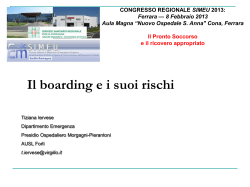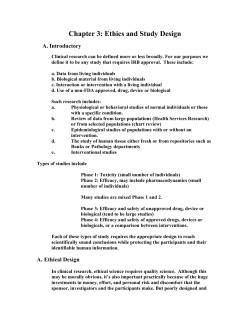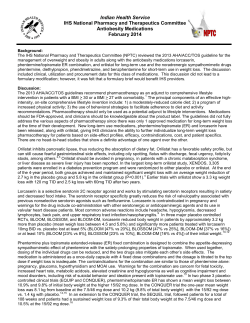
Cardiovascular Safety of DPP IV Antagonists: A Cardiologist’s View
Cardiovascular Safety of DPP IV Antagonists: A Cardiologist’s View Jonathan Howlett MD FRCPC FACC Clinical Professor of Medicine Libin Cardiovascular Institute University of Calgary Faculty/Presenter Disclosure • Faculty: Jonathan Howlett • Relationships with commercial interests: • Grants/Research Support: AstraZeneca, • Merck, Servier, Medtronic Consulting Fees: AstraZeneca, Novartis, Merck, Servier, Pfizer, Medtronic, Abbott • I DO PLAN TO DISCUSS OFF LABEL USE OF MEDICATIONS!! Jon’s • Review findings of the SAVOR TIMI-53 Study • Review findings of the EXAMINE Study • Discuss importance of HF hospitalization as an outcome • Consider impact of SAVOR and EXAMINE in context SAVOR-TIMI 53: Background Information • Saxagliptin is a selective DPP-4 inhibitor1,2 – Indicated as an adjunct to diet and exercise to improve glycemic control in adults with T2DM in multiple clinical settings2 – Reduces fasting and postprandial glucose concentrations and HbA1c in T2DM patients2,3 • Pooled data from 8 Phase 2/3 studies with >4600 patients demonstrated a reduction in CV events with saxagliptin vs comparators; 0.7% vs 1.4% (RR: 0.44; 95% CI: 0.24-0.82)4 – CV events were not adjudicated; overall event rate was low (41 events) • SAVOR-TIMI 53 was designed to meet an FDA postmarketing requirement to assess long-term CV impact of all antidiabetic agents approved since 20085,6 CI: confidence interval; CV: cardiovascular; DPP-4: dipeptidyl peptidase-4; FDA: US Food and Drug Administration; HbA1c: hemoglobin A1c; RR: relative risk; T2DM: type 2 diabetes mellitus. 4 1. Augeri DJ, et al. J Med Chem. 2005;48;5025-5037; 2. Onglyza [prescribing information]; May 2013; 3. Scirica BM, et al. Am Heart J. 2011;162:818-825; 4. Frederich R, et al. Postgrad Med. 2010;122:16-27; 5. FDA. Guidance for Industry. 2008. http://www.fda.gov/downloads/Drugs/GuidanceComplianceRegulatoryInformation/Guidances/ucm071627.pdf. Accessed Aug 2013; 6. Scirica BM, et al. N Engl J Med. 2013.10.1056/NEJMoa1307684. Study Design N≈16,500 patients Documented T2DM and established CVD (secondary prevention) or multiple CV risk factors (primary prevention) RANDOMIZE 1:1 DOUBLE BLIND SAXAGLIPTIN 2.5 mg/d or 5 mg/d Dosing based on eGFR PLACEBO All other diabetes therapy per treating doctors Follow-up visits Q6 months Duration Event driven; ≈1040 events required Final Visit Primary endpoint CV death, non-fatal MI, non-fatal ischemic stroke CVD: cardiovascular disease; eGFR: estimated glomerular filtration rate Scirica BM, et al. Am Heart J. 2011;162:818-825. (Permission requested) Key Inclusion and Exclusion Criteria Inclusion Criteria1 Documented T2DM and HbA1c 6.5% and <12.0%; AND Multiple risk factors: History of Established CVD • 40 yrs OR • Documented atherosclerosis (coronary, cerebrovascular, PV) • 55 yrs (male) or 60 yrs (female) • 1 additional risk factor (dyslipidemia, HTN, smoking) Exclusion Criteria1,2 •Current or previous (within 6 months) incretin-based therapy† •Acute vascular (cardiac or stroke) event <2 months before randomization •Uncontrolled CV or metabolic risk factors •Chronic dialysis, renal transplant, or serum creatinine >6 mg/dL †Includes other DPP-4 inhibitors and GLP-1 agonists GLP-1: glucagon-like peptide 1; PV: peripheral vascular ; HTN = hypertension 1. Scirica BM, et al. N Engl J Med. 2013.10.1056/NEJMoa1307684; 2. Scirica BM, et al. Am Heart J. 2011;162:818-825. Baseline Demographic and Clinical Characteristics Characteristic Age, yrs - mean (SD) Age ≥75 yrs - n (%) Females - n (%) Race - n (%) White Hispanic Established atherosclerotic disease - n (%) Hypertension - n (%) Dyslipidemia - n (%) Prior MI - n (%) Prior heart failure - n (%) Prior coronary revascularization - n (%) Saxagliptin Placebo (N = 8,280) 65.0 (8.5) 1169 (14.1) 2768 (33.4) (N = 8,212) 65.0 (8.6) 1161 (14.1) 2687 (32.7) 6241 (75.4) 1778 (21.5) 6494 (78.4) 6725 (81.2) 5895 (71.2) 3147 (38.0) 1056 (12.8) 3566 (43.1) 6166 (75.1) 1763 (21.5) 6465 (78.7) 6767 (82.4) 5844 (71.2) 3090 (37.6) 1049 (12.8) 3557 (43.3) Yrs: years; SD: standard deviation; IQR: inter-quartile range; BMI: body-mass index Scirica BM, et al. N Engl J Med. 2013.10.1056/NEJMoa1307684. Baseline Renal Function: Overall and Subgroups Saxagliptin Placebo (N = 8,280) (N = 8,212) 72.5 (22.6) 6986 (84.4) 1122 (13.6) 172 (2.1) 72.7 (22.6) 6930 (84.4) 1118 (13.6) 164 (2.0) Albumin/creatinine ratio, mg/mmol –median (IQR) 1.8 (0.7–7.5) 1.9 (0.7–7.9) eGFR, mL/min – mean (SD) >50 mL/min – n (%) 30–50 mL/min – n (%) <30 mL/min – n (%) Albumin/creatinine ratio – n (%) <3.4 mg/mmol 3.4–33.9 mg/mmol >33.9 mg/mmol Scirica BM, et al. N Engl J Med. 2013.10.1056/NEJMoa1307684. 4867 (61.5) 2217 (28.0) 832 (10.5) 4829 (61.6) 2209 (28.2) 806 (10.3) Kaplan-Meier Rates of the Primary Composite Endpoint – CV Death, MI, or Stroke Patients With Endpoints (%) 14 12 Saxagliptin: 7.3%* 10 Rate/100 person-yrs – 3.7 HR 1.00; 95% CI, 0.89–1.12 8 P≤0.001 (NI) 6 P=0.99 (superiority) 4 Placebo: 7.2%* Rate/100 person-yrs – 3.7 2 0 0 Placebo 180 360 8212 7983 7761 Saxagliptin 8280 8071 7836 Days 540 720 900 7267 4855 851 7313 4920 847 *K-M event rates are presented after 2 yrs. HR: hazard ratio; K-M: Kaplan-Meier; Pbo: placebo; Saxa: saxagliptin Scirica BM, et al. N Engl J Med. 2013.10.1056/NEJMoa1307684. 9 Primary and Secondary Endpoints Saxagliptin Placebo n (%; rate)* n (%; rate)* (N = 8,280) (N = 8,212) Primary endpoint CV death, MI, or stroke Secondary endpoint CV death, MI, stroke, hosp for UA, HF, or coronary revasc All-cause mortality HR (95% CI) P value P value NI Superiority 613 (7.3; 3.7) 609 (7.2; 3.7) 1.00 <0.001 (0.89-1.12) 1059 (12.8; 6.6) 1034 1.02 (12.4; 6.5) (0.94-1.11) 0.66 420 (4.9) 378 (4.2) 1.11 (0.96-1.27) 0.15 0.99 *% = K-M event rate at 2 yrs ; rate = rate/100 person-yrs HF: heart failure; hosp: hospitalization: revasc: revascularization; UA: unstable angina Scirica BM, et al. N Engl J Med. 2013.10.1056/NEJMoa1307684. 10 Individual Components of the Composite Endpoints Efficacy endpoint Saxagliptin Placebo n (%)* n (%)* (N = 8,280) (N = 8,212) HR (95% CI) P value CV death 269 (3.2) 260 (2.9) 1.03 (0.87–1.22) 0.72 MI 265 (3.2) 278 (3.4) 0.95 (0.80–1.12) 0.52 Ischemic stroke 157 (1.9) 141 (1.7) 1.11 (0.88–1.39) 0.38 Hosp for UA 97 (1.2) 81 (1.0) 1.19 (0.89–1.60) 0.24 Hosp for HF 289 (3.5) 228 (2.8) 1.27 (1.07–1.51) 0.007 Hosp for coronary revasc. 423 (5.2) 459 (5.6) 0.91 (0.80–1.04) 0.18 *K-M event rates are presented after 2 yrs. Scirica BM, et al. N Engl J Med. 2013.10.1056/NEJMoa1307684. Adjudicated Causes of CV Death Saxagliptin Type Placebo n (%)* (N = 8,280) n (%)* (N = 8,212) 269 (3.2) 260 (2.9) Any CV death HF Acute MI Cerebrovascular Sudden cardiac death Other Presumed CV death 44 (0.5) 23 (0.3) 22 (0.3) 131 (1.6) 14 (0.2) 35 (0.4) HR (95% CI) 1.03 (0.87-1.22) 40 (0.5) 19 (0.2) 35 (0.4) 109 (1.3) 15 (0.2) 42 (0.4) *Event rates are presented after 2 yrs. Scirica BM, et al. N Engl J Med. 2013.10.1056/NEJMoa1307684. P value 0.72 Changes in Antidiabetic and CV Medications Over Time % Baseline Saxa Pbo n= Metformin SU TZD Insulin Other None 8280 69.9 40.5 6.2 41.6 0.6 4.1 8212 69.2 40.0 5.7 41.2 0.6 4.8* n= 8280 8212 75.5 78.3 53.6 28.2 61.6 75.0 78.4 54.9 27.6 61.6 Aspirin Statin ACEi ARB β-blockers Year 1 Year 2 Saxa Pbo Saxa Pbo Antidiabetic medications 7999 7943 5101 5059 69.6 70.1 70.0 69.9 39.7 40.4 39.2 39.5 5.4 5.2 4.7 4.7 42.3 43.6 42.5 45.8† 0.6 0.5 0.6 0.4 4.4 4.3 5.0 4.7 CV medications 7512 7405 3695 3603 77.3 80.8 52.8 29.7 62.6 77.3 80.8 54.2 29.8 62.5 72.7 77.1 52.9 29.7 58.3 72.4 78.7 53.1 31.3 57.2 *P = 0.0496; †P = 0.0008; P = not significant for all other endpoints shown. Scirica BM, et al. N Engl J Med. 2013.10.1056/NEJMoa1307684. End of treatment Saxa Pbo 8041 69.4 39.8 4.9 43.8 0.7 4.5 8007 70.0 40.2 4.7 46.4† 0.6 4.0 7539 7498 77.7 80.5 51.8 30.0 62.8 78.0 81.1 52.4 30.3 62.4 Summary of Findings • The SAVOR-TIMI 53 study of saxagliptin versus placebo when added to standard of care in patients with T2DM at high CV risk demonstrated: – No increased risk of CV death, MI, or ischemic stroke – Significantly improved glycemic control – Prevented of deterioration in microalbuminuria – Increased risk of hospitalization for HF – Increased risk of hypoglycemia – Rates of pancreatitis and pancreatic cancer similar to placebo Scirica BM, et al. N Engl J Med. 2013.10.1056/NEJMoa1307684. Cardiovascular Outcomes With Alogliptin in Patients With Type 2 Diabetes Mellitus and Recent Acute Coronary Syndrome William B. White, MD for the EXAMINE Investigators Cardiology Center, University of Connecticut School of Medicine, Farmington, Connecticut USA Sept-13 EUCAN/ALO/2013-10101 Objectives and End Points of EXAMINE Primary objective: To demonstrate that major CV event rates are not higher with alogliptin than with placebo in type 2 diabetes patients with recent ACS who are receiving standard of care for diabetes and secondary CV prevention – Primary end point: Composite of first occurrence of CV death, nonfatal MI, and nonfatal stroke Secondary objectives: Superiority assessment: If non-inferiority is proven to demonstrate that major CV event rates were lower on alogliptin than with placebo Secondary end point: Evaluate the time from randomization to the first occurrence of the expanded MACE: – Composite of CV death, nonfatal MI, nonfatal stroke, and urgent revascularization due to UA – Major exploratory end points: all CV deaths, all-cause mortality ACS=acute coronary syndrome; CV=cardiovascular; MI=myocardial infarction; UA=unstable angina. White WB, et al. N Engl J Med. 2013. [Epub ahead of print] Study Design • Randomized, double-blind, placebo-controlled study of alogliptin with diabetes standard of care versus placebo with diabetes and cardiovascular standard of care Alogliptina QD + standard of care (N=2701) Treatment period (4.5 years) Placebo QD + standard of care (N=2679) Days –14 to –1 Day 1 Month 1 Month 12 Visits at months 3, 6, and 9 Screening visit End of study Visits every 4 months Baseline/ randomization QD=once daily. aAt randomization, patients assigned to receive 25, 12.5, or 6.25mg QD based on renal function. After randomization, dose adjustments were allowed on the basis of changes in renal function. White WB, et al. Am Heart J. 2011;162(4):620–626. 2-Week follow-up Study Patients • Diagnosis of type 2 diabetes and receiving antihyperglycemic therapy (single or combination therapies) • Acute coronary syndrome* within 15 to 90 days before randomization • Receiving local standard of care for type 2 diabetes care and secondary CV prevention (excluded were DPP-4 inhibitors and GLP-1 agonists) • Patients with unstable cardiovascular conditions or those on dialysis within 14 days of planned randomization were excluded *Myocardial infarction or hospitalized unstable angina White WB, et al. N Engl J Med. 2013. [Epub ahead of print] Baseline Patient Characteristics Duration of diabetes Median, years BMI Median, kg/m2 HbA1C level Mean ± SD, % Qualifying index ACS event for trial entry, No. (%) Myocardial infarction (MI) Procedure-related MI Unstable angina requiring hospitalization Time from index ACS to randomization Median, days Alogliptin (N=2701) Placebo (N=2679) 7.1 7.3 28.7 28.7 8.0 ± 1.1 8.0 ± 1.1 2084 (77) 180 (7) 609 (23) 2068 (77) 188 (7) 605 (23) 44 46 White WB, et al. N Engl J Med. 2013. [Epub ahead of print] Baseline Cardiovascular Therapies Alogliptin (N=2701) Placebo (N=2679) Medications administered at baseline, No. (%) 2630 (97) Antiplatelet agents Aspirin 2448 (91) Thienopyridine 2155 (80) 2602 (97) 2433 (91) 2165 (81) Statins 2446 (91) 2420 (90) β-Blockers 2208 (82) 2203 (82) Renin-angiotensin system blockers 2201 (82) 2210 (83) White WB, et al. N Engl J Med. 2013. [Epub ahead of print] Time to Primary End Point (CV Death, Nonfatal MI, Nonfatal Stroke) Cumulative Incidence of the Primary End Point (%) Hazard ratio, 0.96 (* one-sided repeated CI bound, 1.16) Events, No. (%) Placebo: 316 (11.8) Alogliptin: 305 (11.3) Months Placebo (n): Alogliptin (n): 2679 2701 2299 2316 1891 1899 1375 1394 * Using alpha=0.01. White WB, et al. N Engl J Med. 2013. [Epub ahead of print] 805 821 286 296 Primary End Point by Components Hazard Ratio for Alogliptin Group (95% CI) Alogliptin (N=2701) Placebo (N=2679) 305 (11.3) 316 (11.8) 0.96 (≤1.16)* CV death 89 (3.3) 111 (4.1) 0.79 (0.60 to 1.04) Nonfatal MI 187 (6.9) 173 (6.5) 1.08 (0.88 to 1.33) Nonfatal stroke 29 (1.1) 32 (1.2) 0.91 (0.55 to 1.50) Primary end point: CV death, nonfatal MI, or nonfatal stroke, No. (%) *99% one-sided confidence interval, P<0.001 for non-inferiority White WB, et al. N Engl J Med. 2013. [Epub ahead of print] Other End Points Any CV Death Hazard ratio, 0.85 (95% CI = 0.66 to 1.10) Secondary End Point Hazard ratio, 0.95 (*one-sided repeated CI bound, 1.14) All-Cause Mortality Hazard ratio, 0.88 (95% CI = 0.71 to 1.09) * Using alpha=0.01. White WB, et al. N Engl J Med. 2013. [Epub ahead of print] Summary • Rates of major adverse cardiovascular events were similar with alogliptin compared with placebo in patients with type 2 diabetes and recent acute coronary syndromes • This observation occurred in the following context: – Significantly lower HbA1C level (–0.36%) with alogliptin – High overall CV event rate (11% over the median follow-up of 18 months) – High levels of standard of care for both diabetes and cardiovascular prevention • Outcomes were similar for the secondary end point (composite of CV death, nonfatal MI, nonfatal stroke, urgent revascularization due to UA) White WB, et al. N Engl J Med. 2013. [Epub ahead of print] The meaning of these trials • Not all HF outcomes are the same – Type of New diagnosis – Admission – HF Death • Biomarker profile • Pre-event outcomes • Post-event outcomes Arnold et al, ACC 2012 The Major Types of Heart Failure Hospitalizations Worsening chronic heart failure (75%) De novo heart failure (23%) Advanced/ end-stage heart failure (2%) Fonarow GC. Rev Cardiovasc Med. 2003; 4 (Suppl. 7): 21 Cleland JG et al. Eur Heart J. 2003; 24: 442 Mechanisms for inflammatory immune activation in CHF Adrenergic nervous system RV LV LPS Pro-inflammatory Tissue injury Translocation Bowel wall oedema Hypoxia Immune activation Tissue underperfusion Anker SD, von Haehling S. Heart 2004; 90: 464-70 cytokine activation Myocardial production HF Evolution: Daily mortality rate and log NT-BNP level Hospital Admission Circulation. 2012;126:65-75 EJHF (2011) 13, 142–147 Circulation. 2000;102:1127-1131 All-Cause Mortality Increases With Each Hospitalization Adapted from Setoguchi S et al. Am Heart J. 2007;154:260-266. How Do SAVOR and EXAMINE Measure Up? SAVOR TIMI 53 – Stable patients EXAMINE – Post ACS patients • HF specifically separated • HF NOT specifically mentioned – Mechanism unknown – Further data needed • Isolated CV event noted in past (PPARs) – HF signal then did not portend worse prognosis – Need further data • No conclusions vs. SAVOR until HF data known • Real world registry data needed Implications for a Cardiologist • These results will not concern most cardiologists – CV safety of these two DPP IV agents has been established • No further CV reduction is present • Reasonable reduction in BS noted • Most Cards support the most recent CDA relaxation of BS control guidelines – The HF signal needs further work • What happens to biomarkers • Is there an increased event rate in the future
© Copyright 2025















![[ppt » 3.0MB]](http://cdn1.abcdocz.com/store/data/000728560_1-3d906c162868873f7e39360d83322eae-250x500.png)

![” ⊙ Prohibited Substances [1] Anabolic-Androgenic Steroids](http://cdn1.abcdocz.com/store/data/000006330_2-6488874179c020189ebf4ca4aba01440-250x500.png)



